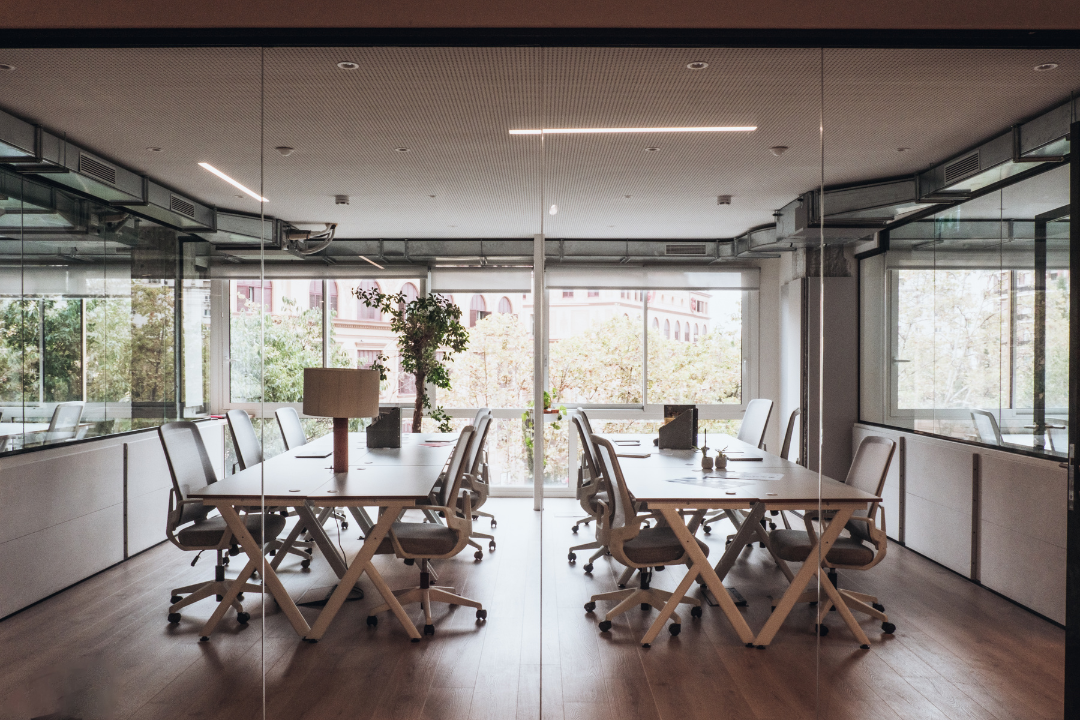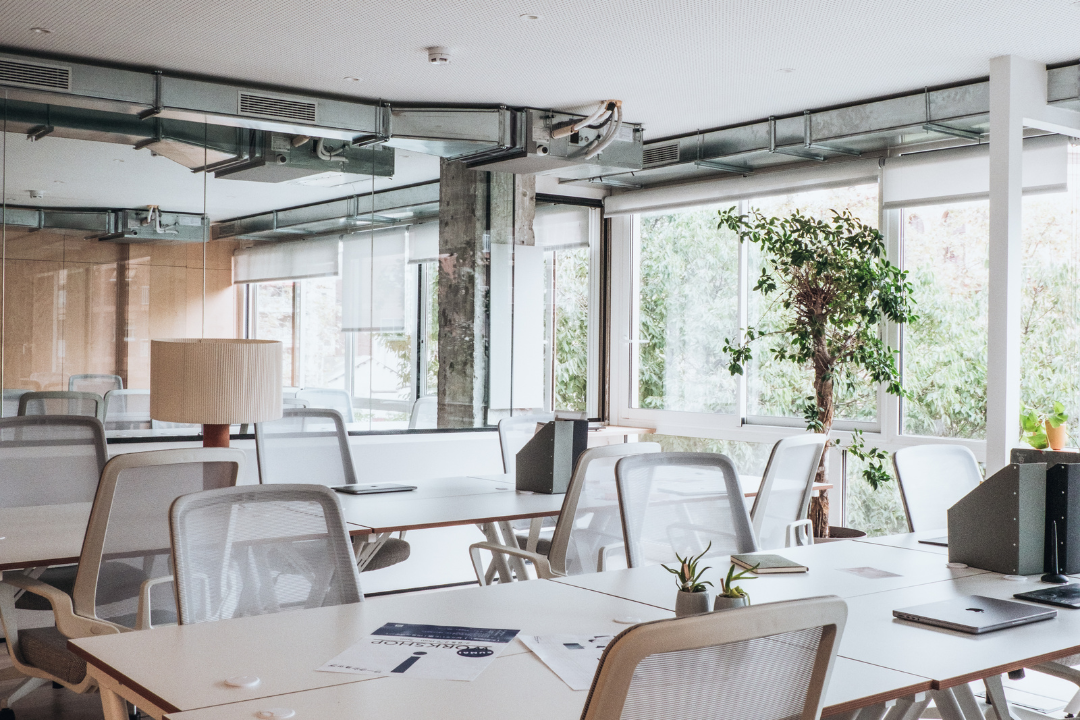As hybrid work blurs the lines between home and office, companies are turning to hot desking to make their spaces work smarter. Hot desking means that employees don’t have a permanently assigned desk. Instead, they choose any available desk when they come into the office. It's a method of desk sharing designed to maximize space usage in hybrid offices.
Hot Desking vs. Other Flexible Models
It’s easy to confuse hot desking with similar approaches. In a coworking space, you’re often sharing a space with people from other companies. Desk hoteling, on the other hand, allows you to reserve desks in advance, like booking a hotel room. With hot desking, it’s often free seating, first come, first served.
In this article, we’ll look at the advantages and disadvantages of hot desking, offering practical advice for HR professionals and office managers trying to improve space utilization and employee satisfaction in today’s hybrid work model.
Hot Desking Pros and Cons: Overview
Here’s a quick summary of hot desking pros and cons:
Hot Desking Advantages

1. Cost Savings & Reduced Overhead
One of the most obvious hot desking advantages is lower operational costs. Companies no longer need to maintain dedicated desk spaces for every employee. That translates to reduced real estate needs, fewer private offices, and a more streamlined office space.
With a well-implemented hot desking arrangement, companies can save significantly on rent, furniture, cleaning, and utilities.
2. Improved Space Efficiency
By eliminating unused desks, we can improve space utilization and make better use of our office layout. Some companies see up to a 40% increase in space efficiency with hot desking solutions.
Flexible workspaces allow us to adjust seating arrangements based on daily needs, which is especially useful in hybrid workplaces where attendance fluctuates.
3. Encourages Collaboration and Cross-Team Interaction
When people don’t sit in the same spot every day, they naturally mix with others. This helps encourage collaboration and reduce departmental silos.
Hot desking supports spontaneous conversations that wouldn’t happen in a traditional office with fixed seating.
4. Ideal for Hybrid and Remote Work Models
In a hybrid work model, not all employees are physically present every day. Hot desking prevents wasting space on empty desks.
For remote workers who only come in occasionally, it makes little sense to have a dedicated desk waiting for them.
5. Supports a More Agile and Modern Work Environment
Hot desking is part of a broader shift toward more agile, flexible workplaces. It aligns with modern office design and innovation goals.
Many companies adopt hot desking systems to stay future-ready, especially when combined with cloud tools and mobile work platforms.
6. Encourages Movement and Activity
Switching desks means we move around more. That small physical activity can help reduce sedentary behavior, improve wellness, and spark creativity.
We can also design spaces with standing desks and informal zones to further support active work environments.
7. Clean Desk Culture Promotes Organization
Since employees can’t leave personal belongings out, hot desking encourages tidiness and organization.
It also makes cleaning protocols easier to manage—something many teams value in a post-COVID workplace.
8. Fairness and Removal of Status Symbols
No more battles over corner offices or window seats. Everyone gets equal access to the same desk options.
This flatter seating arrangement works well in organizations looking to reduce hierarchy and encourage teamwork.
9. Better Adaptability to Changing Teams
For project-based work, it’s often helpful to let teams cluster together temporarily. With hot desks, we can do that without rearranging the whole office.
This flexibility makes onboarding, team changes, or hosting consultants much easier.
10. Tech-Friendly and Future-Proof
Modern hot desking offices use integrated tools like desk booking software to support cloud computing, BYOD policies, and mobile-first workstyles.
These tech-friendly practices help future-proof our office space and improve employee satisfaction through better digital tools.
Cons of Hot Desking: Disadvantages & Challenges

1. Lack of Personal Space and Belongings
One of the most common complaints is the lack of personal space. Without the same desk each day, there’s nowhere to store personal belongings or feel truly settled.
To offset this, some offices offer lockers or mobile storage carts—but it’s not quite the same.
2. Reduced Sense of Belonging and Team Identity
Not seeing your teammates regularly can hinder a sense of community. It’s harder to form bonds when seating is constantly changing.
Over time, this can lead to feelings of detachment and lower morale.
3. Time Wasted Finding a Desk
Without a proper reservation system, hot desking can lead to frustration. Arrive late, and all the good desks may be gone.
A first-come, first-served basis doesn’t work well in large teams. It creates chaos and wasted time.
4. Potential Productivity Drops and Disruption
Setting up your tech every morning—monitor, keyboard, documents—can wear people down.
Lack of consistency in your environment may disrupt your flow, making it harder to get into a productive rhythm.
5. Tech and Ergonomic Inconsistencies
Not all desks are created equal. Some might have dual monitors, others a better chair. This inconsistency creates frustration and even physical discomfort.
Standardizing workstations and providing adjustable chairs can help.
6. Hygiene and Cleanliness Concerns
With shared desks, hygiene becomes a real concern. Especially post-pandemic, employees want clean, sanitized spaces.
Offices need policies around daily cleaning, sanitizing supplies, and personal hygiene practices.
7. Role Incompatibility
Not all roles are suited to hot desking. Engineers, finance teams, or legal staff might need specific hardware or storage space.
Anyone handling confidential materials might struggle in a free-seating environment.
8. Loss of Structure and Routine
Some people thrive on routine. Constantly changing desks can disrupt those who rely on predictable environments.
A lack of structure may lead to reduced productivity for certain personality types.
9. Communication Inefficiencies
Finding colleagues can become a game of hide-and-seek. Even in the same building, people default to Slack or email rather than locating someone physically.
This can slow down decisions and fragment team dynamics.
10. Resistance to Change
For many employees, hot desking is a big shift, especially for those used to traditional office setups.
HR teams need to support this transition with clear communication, empathy, and good training. Change management matters.
What Hot Desking Really Requires to Succeed

Implementing hot desking successfully requires more than just eliminating assigned seating, it demands the right tools, clear policies, and ongoing support.
First, having a desk booking software is essential. It prevents first-come, first-served chaos by allowing employees to reserve desks in advance, ensuring a smooth and fair experience.
Next, the physical workspace needs to be arranged thoughtfully. Standardized workstations help avoid ergonomic inconsistencies, and storage solutions like lockers or mobile caddies allow employees to keep personal items secure.
Leadership also plays a vital role. Executives and managers must support the transition and set an example. Communicating the “why” behind hot desking, from cost savings to hybrid work enablement, builds trust and clarity.
Finally, training and team communication are crucial. Equip employees with clear guidelines, offer training on new tools, and maintain open channels for feedback to continuously improve the setup.
Hot Desking vs. Assigned Desks vs. Hoteling: What’s Best for Your Office?

Each seating model offers different advantages depending on your organization’s needs:
- Hot Desking means no assigned seating. Employees pick any open desk each day. It’s highly flexible and cost-efficient but requires strong systems to avoid frustration.
- Assigned Desks give each employee a permanent space. This model supports personalization, consistency, and structure — ideal for focused work or privacy-focused roles.
- Desk Hoteling is a hybrid approach where employees reserve desks in advance. It combines the predictability of assigned desks with the flexibility of desk sharing.
So which should you choose? Assigned desks work well when routine, privacy, or specialized equipment is important. Hot desking suits flexible, agile teams who value variety and autonomy. Hoteling is often the most efficient model for large organizations with hybrid schedules.
For more guidance, check out our full guide on Office Hoteling vs Hot Desking.
Take the First Step to Seamless Hot Desking
Hot desking offers major benefits, from reduced real estate costs to better support for hybrid work. But making it successful comes down to execution.
The right systems can eliminate the most common challenges. A desk booking software like elia:
- Helps manage available desks in real time
- Prevents first-come, first-served frustration
- Enhances space utilization and planning
- Improves employee satisfaction with a predictable, fair process
With the right tools in place, hot desking becomes an asset, not a hassle. Book a free demo with Elia today to discover how we can help you design a smarter, more flexible workplace.


.png)
.png)
![Conference Room Automation: The Complete Guide to Smarter Meetings [2026]](https://cdn.prod.website-files.com/64f88f68249f7cafe071d150/69383a535f2d6b279898c8ef_151.png)
%20(1).png)